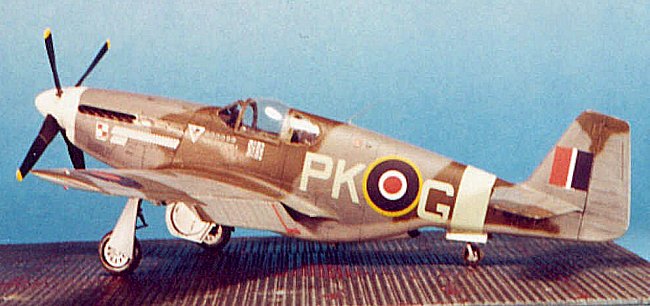
Tamiya 1/48 Mustang III
|
KIT # |
61047 |
|
PRICE: |
$26.00 |
|
DECALS: |
See review |
|
REVIEW : |
|
|
NOTES: |
|

|
HISTORY |
Eugeniusz Horbaczewski and the Polish Mustang Wing:
The successful installation of a Merlin 60-series engine in a Mustang I created an entirely different airplane from the earlier Allison-powered Mustangs. Known in the RAF as the Mustang III, the airplane did not serve in large numbers with the original service to order the Mustang, due to the fact that the U.S. Eighth Air Force had first claim on the first fighter that could escort the bombers over the most distant target and outfight the defending German fighters on more than equal footing.
In the event, the RAF was only able to form two wings on the Mustang III in the ETO, for a total of seven squadrons. The first wing only became operational in mid-February, 1944, due to the fact that 36 of the Mustangs originally slated for 19, 65 and 122 Squadrons were diverted to the USAAF in order to equip the U.S. Fourth Fighter Group; their first missions at the end of the month included escort of U.S. heavies during "Operation Argument" - aka "The Big Week" - the first U.S. bombing attacks against Germany in which there was a sufficient weight of bombers to have a serious effect, and enough fighters to give them the protection they lacked the previous summer and fall.
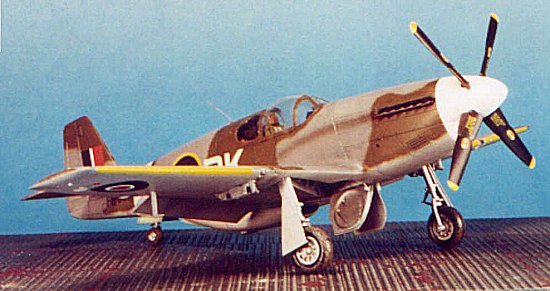 In April, 1944, 129 RAF squadron joined 306 "City of Torun" and 315
"City of Deblin" squadrons of the Polish Air Force in 133 Wing. The
following month they were joined by the seventh Mustang III squadron, 316
"City of Warsaw." Wing Commander Stanislaw Skalski, who would become
the top ace of the Polish Air Force in the Second World War became O.C. 133
Wing. With the range of the Mustang III, 133 Wing's first assignments were to
fly fighter escort for the Beaufighters and Mosquitos of Coastal Command on
their strikes against Norway. This almost-forgotten war was one of the most
dangerous for aircrew, with strike aircraft and their escorts making long
over-water flights at low level to face a well-armed enemy when they arrived at
the target, then returning the same way; no aircrew lost over the cold North Sea
on these operations - other than those who could make it to the Scottish coast -
was ever rescued before they succumbed to exposure after ditching.
In April, 1944, 129 RAF squadron joined 306 "City of Torun" and 315
"City of Deblin" squadrons of the Polish Air Force in 133 Wing. The
following month they were joined by the seventh Mustang III squadron, 316
"City of Warsaw." Wing Commander Stanislaw Skalski, who would become
the top ace of the Polish Air Force in the Second World War became O.C. 133
Wing. With the range of the Mustang III, 133 Wing's first assignments were to
fly fighter escort for the Beaufighters and Mosquitos of Coastal Command on
their strikes against Norway. This almost-forgotten war was one of the most
dangerous for aircrew, with strike aircraft and their escorts making long
over-water flights at low level to face a well-armed enemy when they arrived at
the target, then returning the same way; no aircrew lost over the cold North Sea
on these operations - other than those who could make it to the Scottish coast -
was ever rescued before they succumbed to exposure after ditching.
By late May, 133 Wing was participating in dive-bombing operations against the Channel coast in preparation for the coming invasion. As of June 6, the wing had not had the chance to test their new mounts against German aerial opposition, though four pilots of 306 squadron had jointly shot down a He-111 they came across during a "Ranger" mission to Orleans on May 18.
Among the elite Polish pilots assigned to 133 wing was Captain Eugeniusz Horbaczewski, C.O. of 315 Squadron, one of the leading aces and personalities of the Polish Air Force. Horbaczewski had come to prominence the previous year as a member of the Polish Fighting Team attached to 145 Squadron in Tunisia, where he had scored 5 or the 75 kills attributed to the team during the two months they fought at the conclusion of the Tunisian campaign.
During the invasion, the two wings of Mustang IIIs were given responsibility for cutting off German forces in the beachhead, with deep-penetration missions laid on at a rate of 2-3 missions per day for attacks against German ground targets and pursuit of the Luftwaffe, which had finally made its appearance in the battle. On the morning of June 12, Horbaczewski led four Mustangs of 315 Squadron on a dive-bombing mission north of Mortagne, during which they ran across seven Fw-190s at low level. Horbaczewski and F/O Kirste got one each, while F/S Bargielowski got two.
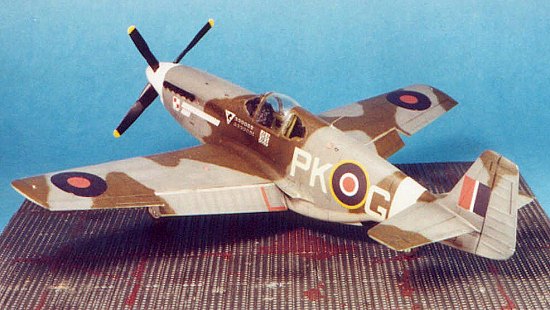 On June 22, Horbaczewski led another strafing mission, during which two
pilots were downed by flak. Horbaczewski saw W/O Tamowicz crash-land in a marsh,
then spotted an American Emergency Landing Strip (ELS) under construction
nearby. He landed, borrowed a jeep, and drove to the scene of the crash. Wading
through hip-deep mud and water, he got to the Mustang and pulled the wounded
Tamowicz from the wreck, got him back to the jeep and back to the ELS. Tamowicz
climbed into the C.O.'s airplane, and Horbaczewski sat on his lap in order to
fly them both back to England.
On June 22, Horbaczewski led another strafing mission, during which two
pilots were downed by flak. Horbaczewski saw W/O Tamowicz crash-land in a marsh,
then spotted an American Emergency Landing Strip (ELS) under construction
nearby. He landed, borrowed a jeep, and drove to the scene of the crash. Wading
through hip-deep mud and water, he got to the Mustang and pulled the wounded
Tamowicz from the wreck, got him back to the jeep and back to the ELS. Tamowicz
climbed into the C.O.'s airplane, and Horbaczewski sat on his lap in order to
fly them both back to England.
In mid July, 133 Wing was pulled out of 2TAF and reassigned to Air Defense of Great Britain to participate in the anti-diver patrols against the newly-introduced V-1 flying bombs.
After a successful campaign against the V-1s, during which he personally shot down four of the flying bombs, Horbaczewski led 315 on their first air-combat mission since their withdrawal from France. The mission of 18 August, 1944, was against the Luftwaffe base at Beauvais. Upon arrival, the squadron found surprised 60 Fw-190s taking off and landing at the field. In a 15-minute fight, the 16 Mustangs dispatched 16 Fw-190s, including Horbaczewski's 16th, 17th and 18th victories. As he opened fire on the last victim, a Focke-Wulf rolled in on Horbaczewski's tail and delivered a fatal burst; the Mustang was seen to roll on its back and dive straight in, exploding upon impact.
|
THE KIT |
I don't think I can add anything new to what has been said about the Tamiya P-51B Mustang kit since its first appearance in 1995. The kit easily makes up into an accurate representation of what I think is the best-looking Mustang, though purists will point out that the cockpit floor is accurate for an Allison Mustang, not the Merlin-powered "B." For those with a dedication to accuracy, there are several aftermarket resin cockpits for this kit that correct this deficiency. For myself, I've had no problem living with that minor discrepancy, which is not all that visible to any but the Mustang experte once the model is assembled.
After releasing the P-51B with markings for Don Gentile's "Shangri-La," Tamiya released this kit of the Mustang III, with a molded Malcolm hood which is unfortunately a bit thick and distorted, with decals for three different Mustang IIIs - one from 112 Squadron in Italy with the famous sharkmouth, one from the latter days of the war flown by 315 Squadron in natural metal finish, and Horbaczewski's last Mustang III, which is the airplane I decided to do. The kit decals are from Scalemaster, and are superior to the standard Tamiya decals, being thinner, and of correct colors.
|
CONSTRUCTION |
Again, what can I say? Follow the instructions and get a great-looking model. I did opt to use the vacuformed Malcolm hood from Squadron's Mustang canopy set, so that I could close up the canopy (to me, the Malcolm-hood Mustang looks best this way) without losing the ability to see the cockpit. I used an old set of True Details photo-etch seatbelts; these two items were my only concession to aftermarket supplies.
|
PAINT & DECALS |
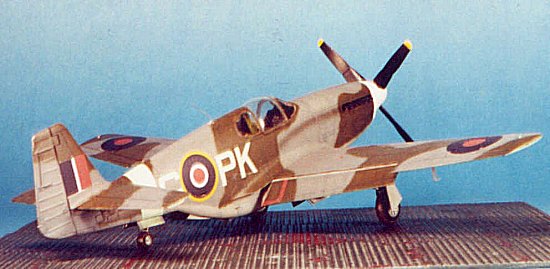 There has been a bit of controversy among
cognoscenti about Horbaczewski's
final Mustang. At the time, all Allied aircraft were supposed to have black and
white "invasion stripes." There is a photo of Horbaczewski in a
Mustang that is so marked, and there is also a photograph of him in front of
this, his final Mustang (which can be so identified because it has the complete
set of personal markings and score board - the Poles were the only RAF fliers to
mark their airplanes this way consistently), and it is clear that this airplane
not only does not have the "Normandy stripes," but that it never
carried them since one can clearly see on the wings and fuselage that there is
no evidence of the stripes being removed. I personally find this explanation
compelling: when 133 Wing was brought back to England for anti-Diver operations,
their Mustangs had been ridden hard and hung up wet for nearly three months of
continuous combat operations; these were "tired ponies." The squadrons
were likely re-equipped with new airplanes from the maintenance units, which
they didn't bother to mark with the stripes since they wouldn't be flying over
the invasion - not to mention the added weight and air resistance of the extra
paint would have an adverse effect on airplanes where the performance edge
between it and its prey was as narrow as it was with the V-1. Thus, these
Mustangs would have likely been the only ones in England without the invasion
markings. They were, however, painted with the standard "Mustang ID"
of white spinner and 12-inch noseband that had been adopted earlier in the year
to distinguish the Mustang from the Bf-109.
There has been a bit of controversy among
cognoscenti about Horbaczewski's
final Mustang. At the time, all Allied aircraft were supposed to have black and
white "invasion stripes." There is a photo of Horbaczewski in a
Mustang that is so marked, and there is also a photograph of him in front of
this, his final Mustang (which can be so identified because it has the complete
set of personal markings and score board - the Poles were the only RAF fliers to
mark their airplanes this way consistently), and it is clear that this airplane
not only does not have the "Normandy stripes," but that it never
carried them since one can clearly see on the wings and fuselage that there is
no evidence of the stripes being removed. I personally find this explanation
compelling: when 133 Wing was brought back to England for anti-Diver operations,
their Mustangs had been ridden hard and hung up wet for nearly three months of
continuous combat operations; these were "tired ponies." The squadrons
were likely re-equipped with new airplanes from the maintenance units, which
they didn't bother to mark with the stripes since they wouldn't be flying over
the invasion - not to mention the added weight and air resistance of the extra
paint would have an adverse effect on airplanes where the performance edge
between it and its prey was as narrow as it was with the V-1. Thus, these
Mustangs would have likely been the only ones in England without the invasion
markings. They were, however, painted with the standard "Mustang ID"
of white spinner and 12-inch noseband that had been adopted earlier in the year
to distinguish the Mustang from the Bf-109.
Another thing is that there is now new information about the correct colors of the camouflage paint on Mustang IIIs. They were not painted in the standard RAF day fighter colors of Ocean Grey, Dark Green and Sea Grey Medium, but rather used U.S. "equivalent colors" when they were so painted at the North American factory. These colors are Sea Grey (equivalent of British Dark Sea Grey) in place of Ocean Grey, Olive Drab (not the Shade 41 aviation color but the earlier, more greenish, standard Army Olive Drab found on ground vehicles) for Dark Green, and Sky Grey (a light grey) in place of Sea Grey Medium. Once in England, they were given the Sky fuselage band and the white spinner and nose band.
For my model, I used Gunze-Sanyo H-331 "Dark Sea Grey," Gunze-Sanyo H-52 "Olive Drab 1," and Tamiya XF-19 "Sky Grey", all thinned 1:1 with rubbing alcohol and painted freehand with my Paasche Model H airbrush.
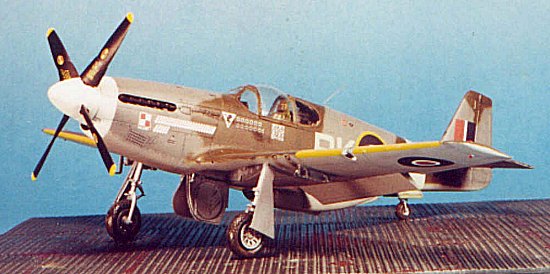 I painted the wheel wells, gear legs and interior of the gear doors Testor's
Metalizer non-buffing Aluminum - the accurate color for Mustang wheel wells and
gear doors - with the main spar that forms the rear of the wheel well painted
zinc chromate. I overpainted the wheel wells with some thinned-down Tamiya
"Smoke" to pop out the detail and give the effect of oil and dirt that
would collect there.
I painted the wheel wells, gear legs and interior of the gear doors Testor's
Metalizer non-buffing Aluminum - the accurate color for Mustang wheel wells and
gear doors - with the main spar that forms the rear of the wheel well painted
zinc chromate. I overpainted the wheel wells with some thinned-down Tamiya
"Smoke" to pop out the detail and give the effect of oil and dirt that
would collect there.
I applied the kit decals, which went down without difficulty under a coat of Micro-Sol. Once these were dry, I gave the model two coats of my "Flat Future" mix. I did not weather the model past applying some exhaust and gunfire stains with Tamiya "Smoke" and a bit of scuffing with Testor's Metalizer non-buffing "Aluminum" for the left wing where the pilot boarded the aircraft, since the photo of Horbaczewski's airplane shows it was very clean and well-maintained. When all this was dry, I attached the landing gear and gear doors, and the propeller blades.
|
CONCLUSIONS |
The RAF scheme for the Mustang III is one of the most attractive schemes the airplane appeared in. This is an easy project that will provide a very nice result with a modicum of effort.
Copyright ModelingMadness.com. All rights reserved. No reproduction in part or in whole without express permission from the editor.
If you would like your product reviewed fairly and fairly quickly, pleasecontact the editor or see other details in the Note to Contributors.
Back to Reviews Page 2024